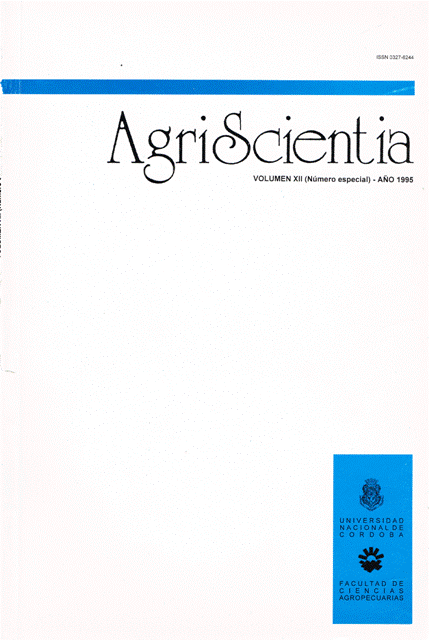The moisture anomaly index z and its relationship with wheat yield in Bordenave (Buenos Aires, Argentina)
Main Article Content
Abstract
A linear regression model for the estimation of wheat crop yields in the dry sub-humid region of Buenos Aires Province for the period 1965-1991 is presented. A Mexican germplasm was introduced in the crops, as well as new technology in tillage systems and crop sanitation. The model is techno-agroclimatic, with a linear term accounting for the technological trend and an agroclimatic term with independent variables from the Palmer hydrologic balance. The regression equation estimates 82.4% of yield variation, with a standard error of 1.43 qq/ha. The model was validated with additional data.
Article Details

This work is licensed under a Creative Commons Attribution-ShareAlike 4.0 International License.
How to Cite
References
Baler, W., & Robertson, G. W. (1968). The performance of soil moisture estimates as compared with direct use of climatological data for estimating crop yields. Agricultural Meteorology, 5, 17-31.
Callis, S. L., & Sakamoto, C. (1984). Argentina wheat yield models. AISC Models Branch, 34 pp.
Donnari, M., & Scian, B. (1994). Sequías edáficas en Bordenave. Método de Palmer. Revista Geofísica, N° 39, 85-99.
Draper, N. R., & Smith, H. (1981). Applied regression analysis (2ª ed.). John Wiley & Sons, 709 pp.
Duchon, C. E. (1986). Corn yield prediction using climatology. Journal of Climate and Applied Meteorology, 25(5), 581-590.
Espoz, C., & Brizuela, A. (1983). Comunicación sobre el desarrollo de un sistema de predicción y monitoreo del cultivo de trigo para la pradera pampeana. Meteorológica, Vol. XIV, N°1 y 2, 757-771.
Jones, C. A., Ritchie, J. T., Kiniry, J. R., Godwin, D. C., & Otter, S. I. (1984). The CERES wheat and maize models. Proceedings of the International Symposium on Minimum Data Sets for Agrotechnology Transfer, ICRISAT Center, India, 95-100.
Magrín, G., Díaz, R., Rebella, C., Del Santo, C., & Rodríguez, R. (1991). Simulación del crecimiento y desarrollo de trigo en la Argentina y la necesidad de información meteorológica de entrada. Anales del Sexto Congreso Argentino de Meteorología (CONGREMET VI), Buenos Aires, Argentina, 49-50.
Meyer, S. J., Hubbard, K. G., & Wilhite, D. A. (1993a). A crop-specific drought index for corn. I. Model development and validation. Agronomy Journal, 86, 388-395.
Meyer, S. J., Hubbard, K. G., & Wilhite, D. A. (1993b). A crop-specific drought monitoring and assessment. Agronomy Journal, 86, 396-399.
Nix, H. A., & Fitzpatrick, E. A. (1969). An index of crop water stress related to wheat and grain sorghum yields. Agricultural Meteorology, 6, 321-337.
Palmer, W. C. (1965). Meteorological drought. U.S. Department of Commerce, Weather Bureau, Research Paper 45, 58 pp.
Ritchie, J. T., & Otter, S. (1985). Description and performance of CERES-Wheat: A user-oriented wheat yield model. Department of Agriculture, Agricultural Research Service, ARS-38, 159-175.
Sakamoto, C. M. (1978). The Z index as a variable for crop yield estimation. Agricultural Meteorology, 19, 305-313.
Sakamoto, C. M., & Jensen, R. E. (1975). Wheat climate models for Argentina and Australia. Final Report submitted to the Environmental Data Service, Center for Climatic and Environmental Studies, Service Center, National Weather Service, NOAA, Auburn University, Auburn, Ala.
Seber, G. A. F. (1977). Linear regression analysis. John Wiley & Sons, 465 pp.
Sierra, E. M., & Brynsztein, S. M. (1990). Wheat yield variability in the SE of the province of Buenos Aires. Agricultural and Forest Meteorology, 49, 281-290.





